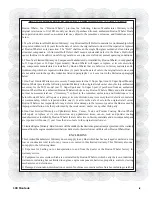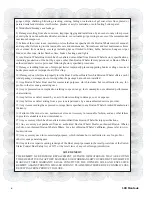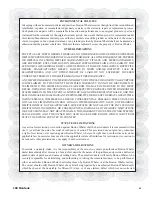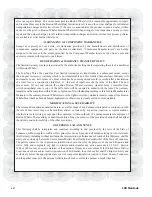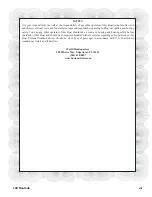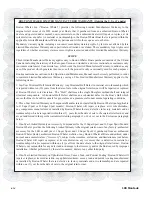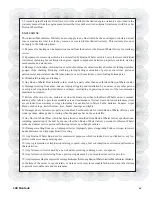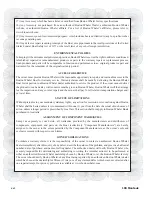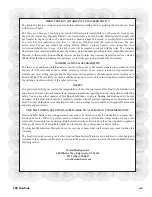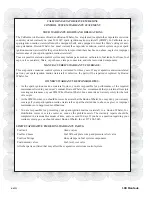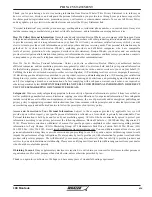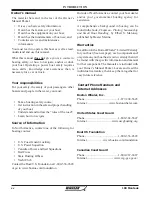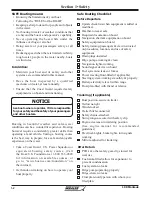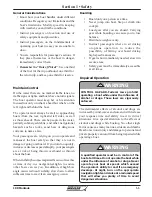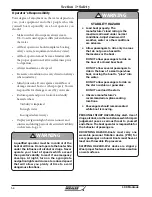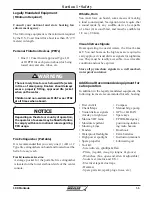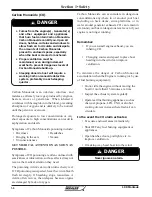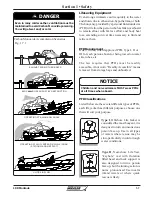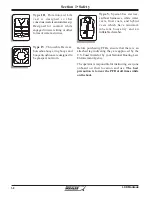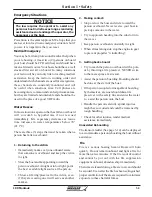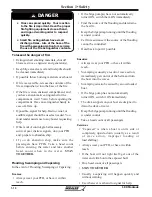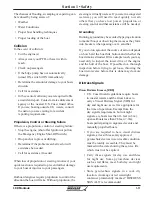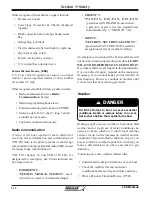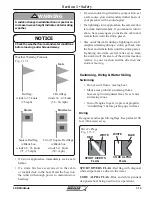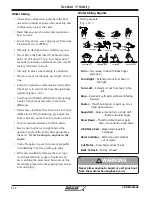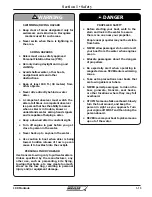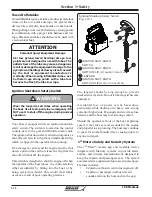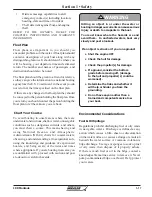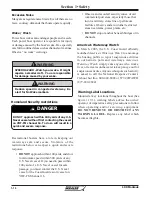
1-3
190 Montauk
Section 1 • Safety
R
General Considerations
• Know how your boat handles under different
conditions. Recognize your limitations and the
boat’s limitations. Modify speed in keeping
with weather, sea and traffic conditions.
• Instruct passengers on location and use of
safety equipment and procedures.
• Instruct passengers on the fundamentals of
operating your boat in case you are unable to
do so.
• You are responsible for passenger’s actions. If
they place themselves or the boat in danger,
immediately correct them.
•
Remember the “Rule of Thirds”
: Use one third
of the fuel for the trip outbound, one third for
the return trip, and keep one third for reserve.
Maintain Control
On the water there are no marked traffic lanes, no
traffic signs or lights, and boats have no turn signals.
The boat operator must keep her or his attention
focused not only on what’s ahead but what’s on the
left, right and behind the boat.
The operator must always be alert to approaching
boats (from the rear, right and left sides, as well
as those ahead). There can be people in the water,
partially submerged debris, and other navigational
hazards such as rocks, sand bars or dangerous
currents, to name a few.
Your passengers are relying on you to operate and
maneuver the boat safely so that they are not in
danger of going overboard. If you turn too quickly,
increase or decrease speed abruptly, your passengers
are at risk of being thrown overboard or thrown
about the boat.
When visibility becomes impaired because of weather
or time of day, use navigational lights to ensure
other boats can see you. In addition, if high bow
angle causes reduced visibility, slow down to allow
sufficient time to react if an emergency occurs.
Boarding
• Board only one person at a time.
• Never jump into boat. Step or climb into
cockpit.
• Load gear after you are aboard. Carrying
gear while boarding can cause you to lose
balance.
• Distribute weight evenly.
• Instruct passengers where to sit during
on-plane operation to reduce the
possibility of falling overboard during
high speed maneuvers.
• If gear is not immediately needed, stow it in
secure areas.
• Safety gear must be immediately accessible
at all times.
A qualified operator must be in control of the
boat at all times. Do not operate the boat while
under the influence of alcohol or drugs. Never
operate your boat at speeds which exceed
the operator’s ability to react if an emergency
develops. At night, turn on the appropriate
navigation lights and cruise at a reduced speed
that will allow you plenty of time to avoid
dangerous situations.
!
WARNING
The detrimental effects of alcohol and drugs are
increased by wind, waves and sun, and will decrease
your response time and ability to act in critical
situations. Give special attention to the effects of
alcohol and drugs while boating. No other single
factor causes as many marine accidents and deaths.
Death or serious injury and damage to personal and
private property can result from being impaired while
operating a boat.
Impaired Operation
CONTROL HAZARD-Federal laws prohibit
operating a boat while under the influence of
alcohol or drugs. These laws are vigorously
enforced.
!
WARNING
Summary of Contents for 190 Montauk
Page 1: ...190 Montauk Owner s Manual ...
Page 43: ...1 22 190 Montauk Section 1 Safety R THIS PAGE INTENTIONALLY LEFT BLANK ...
Page 69: ...2 26 190 Montauk Section 2 General Information R THIS PAGE INTENTIONALLY LEFT BLANK ...
Page 87: ...4 6 190 Montauk Section 4 Electrical System R Switch and Breaker Panel Schematic Fig 4 6 1 ...
Page 88: ...4 7 190 Montauk Section 4 Electrical System R Switch and Breaker Panel Schematic Fig 4 7 1 ...
Page 89: ...4 8 190 Montauk Section 4 Electrical System R THIS PAGE INTENTIONALLY LEFT BLANK ...
Page 103: ...5 14 Section 5 Care Maintenance R 190 Montauk THIS PAGE INTENTIONALLY LEFT BLANK ...

